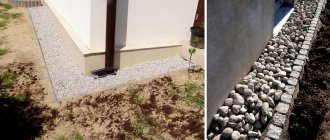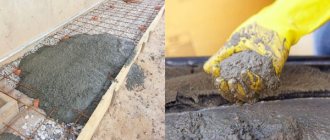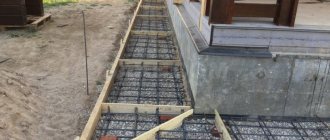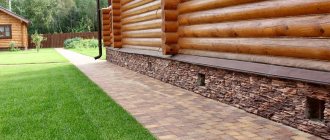A path built around the perimeter of a house, the purpose of which is to remove moisture from the foundation, is called a blind area. This is a very important element that protects the base and guarantees a long service life of the structure. This structure can be constructed from various materials, but the main thing is to follow the technology so that the blind area can perform its functions.
“Soft” protection of the base part
Why do you need a blind area around the house?
What is better to make a blind area around the house?
The main task of the blind area around the house is to drain water from the foundation, which prevents its destruction and deformation of the load-bearing walls. Also, with proper insulation, the blind area is an additional element of the warm contour of the house, which prevents heat loss and freezing of the soil under the house. And finally, the blind area is nothing more than an excellent path around the building and an original object of landscape design for your site.
Feasibility of construction
A solid blind area is the most popular option used to remove moisture from the foundation, thereby extending its service life.
But it will not always function correctly, for example, in conditions of heaving soil, a solid structure is rarely used .
In this case, it is advisable to install a soft blind area, which is simpler, cheaper and more repairable. In addition, you can put insulation and waterproofing, as a result of which the structure will perform the same functions as a solid one.
Types of blind areas or what is best to use to make a blind area around the house
We have decided that it is necessary to make a blind area around the house. Let's look at what types of blind areas there are and what is best to make a blind area around the house from. You can make a classic concrete blind area followed by surface cladding or a soft blind area. Their differences are visible even from the terminology. But the principle of performing its functions is the same. The classic concrete blind area can then be lined with porcelain stoneware, paving slabs, clinker bricks, natural stone and other finishing materials.
Advice! A modern architectural solution, with a certain design idea, would be a polished concrete blind area with iron plating or topping of the top layer. This work can be done immediately after pouring the blind area, saving on subsequent cladding, following the technology.
An excellent low-cost solution for a blind area around the house would be to organize a soft blind area made of crushed stone or natural lawn. This method is supported by the lower cost of materials and work, the possibility of independent execution, as well as an excellent aesthetic appearance. Such a blind area is little susceptible to the forces of frost heaving and is not destroyed. I will say more, in many countries today this is the method most often used.
The cheapest and easiest option
A soft blind area is considered the most inexpensive and simple way to protect the foundation from moisture. Crushed stone or sand are most often used for the top layer ; they are cheaper and easier to work with.
The most economical and simple option is to plant ornamental grass or form a flower bed on a blind area. This will not only reduce the financial costs of arrangement, but also improve the appearance of the site.
It is better not to skimp on waterproofing and geotextiles, as they play a primary role in structural reliability and durability.
It is worth noting that the soft blind area is highly susceptible to spreading, since bulk materials are most often used for the top layer. To prevent this, a concrete curb is laid around the perimeter of the structure .
To make it cheaper, it can be replaced with wooden formwork, which is mounted in poured clay. Such a barrier is capable of retaining bulk material and also maintaining the integrity of the structure.
Over time, the wooden formwork can be dismantled and a concrete curb installed in its place.
Concrete blind area of the house
A classic concrete blind area, if all the rules for its construction are observed, is a reliable and durable solution, but at the same time the most labor-intensive and financially expensive. Let's consider the technology used to build such a blind area. In the presented figure you can see a diagram of the correct concrete blind area.
Concrete blind area
Insulation of the blind area
To estimate the labor costs and financial component, the construction of a blind area can be divided into separate works, which are done in the following order: Excavation, excavation, moving soil over a distance of up to 50 meters. Be sure to move the excavated soil away from the house so that the blind area is higher than the ground level around it.
Advice! Remove only fertile soil and control it, about 40 cm, and make sure that you don’t remove excess soil, otherwise you will have to fill it with sand and compact it, and this is an extra cost.
Organization of slope on the ground. This can be done with a shovel and a level. Soil compaction. If you have clay under the fertile layer, then you can create a so-called clay castle by compacting it, it will work as an additional layer of waterproofing. If your foundation is not insulated, then at this stage insulate it using EPS with a thickness of at least 5 cm, preferably 10 cm. Laying geotextiles Arranging a cushion of sand and crushed stone with layer-by-layer compaction while maintaining the slope Laying EPS insulation at least 5 cm, preferably 10 cm. maintaining the slope Laying waterproofing. You can use roll waterproofing based on bitumen. Make sure that the waterproofing extends to the foundation Laying the reinforcing mesh on supports, it is better to use a 10 by 10 mesh grid. Setting up the formwork Installing built-in rainwater inlets and leading pipes beyond the perimeter of the blind area in the direction of water flow Pouring concrete manually with a slope and expansion joints or pouring concrete using the commercial method concrete with slope and expansion joints. The screed must be at least 10 cm at its thinnest point and must be made with a grade of concrete not lower than M 300. After the concrete screed has dried, you can begin cladding the blind area using clinker tiles, natural stone, frost-resistant porcelain stoneware or paving slabs.
The PLANTER GEO membrane is responsible for water drainage
This is an elastic fabric made of high density polyethylene (HDPE) with a thickness of 0.6 mm. It does not absorb water and has high tensile strength. The membrane is resistant to soil heaving and prevents plant roots from growing through it.
The membrane has an additional layer of geotextile - it is necessary to filter incoming moisture. Without it, drainage channels can quickly become clogged with sand and soil particles, causing the drainage system to lose its effectiveness. Therefore, the PLANTER GEO membrane uses Typar geotextiles from DuPont with silt resistance and increased service life.
Water calmly passes through the geotextile filter layer, and then is removed down a slope along a plastic sheet and enters the soil or surface drainage system at a safe distance from the house. To do this, the soft blind area is laid at a distance equal to the width of the roof overhang plus 20 cm. The most popular blind area width is 1 m.
Soft blind area
A soft blind area, if all the rules for its construction are observed, is a reliable and durable solution, while it is less labor-intensive and financially economical. Let's consider the technology used to build such a blind area.
To estimate the labor costs and financial component, the construction of a soft blind area can be divided into separate works, which are done in the following order:
If you decide to make a blind area from crushed stone, then the sequence of work will be as follows:
Excavation work, excavation, moving soil over a distance of up to 50 meters. Be sure to move the excavated soil away from the house so that the blind area is higher than the ground level around it. If your foundation is not insulated, then at this stage insulate it using EPS with a thickness of at least 5 cm, preferably 10 cm. Organize a slope on the ground. This can be done with a shovel and a level. Soil compaction. If you have clay under the fertile layer, then you can create a so-called clay castle by compacting it, it will work as an additional layer of waterproofing. Laying EPS insulation at least 5 cm, preferably 10 cm while maintaining the slope. Laying waterproofing. You can use roll waterproofing based on bitumen. Make sure that the waterproofing goes to the foundation. Install a cushion of sand and crushed stone with layer-by-layer compaction while maintaining the slope. Installation of built-in storm water inlets and removal of pipes beyond the perimeter of the blind area in the direction of water flow Laying geotextiles Filling the blind area with a finishing coating of fine crushed stone. An excellent solution would be to use marble chips or river pebbles. Or backfilling the blind area with a finishing coating of fine crushed stone. An excellent solution would be to use marble chips or river pebbles.
If you decide to make a blind area with a lawn, then the sequence of work will be as follows:
Excavation work, excavation, moving soil over a distance of up to 50 meters. Be sure to move the excavated soil away from the house so that the blind area is higher than the ground level around it. If your foundation is not insulated, then at this stage insulate it using EPS with a thickness of at least 5 cm, preferably 10 cm. Organize a slope on the ground. This can be done with a shovel and a level. Soil compaction. If you have clay under the fertile layer, then you can create a so-called clay castle by compacting it, it will work as an additional layer of waterproofing. Laying EPS insulation at least 5 cm, preferably 10 cm while maintaining the slope. Laying waterproofing. You can use roll waterproofing based on bitumen. Make sure that the waterproofing goes to the foundation
Construction of a cushion of sand and crushed stone with layer-by-layer compaction while maintaining the slope. Installation of built-in storm water inlets and pipes outside the perimeter of the blind area in the direction of water flow Laying geotextiles Backfilling fertile soil with its compaction and sowing or laying a lawn. In the presented figure you can see the diagram of the correct soft blind area with a lawn
Lawn blind area
If you decide to make a blind area with paving slabs, then the sequence of work will be as follows:
Excavation work, excavation, moving soil over a distance of up to 50 meters. Be sure to move the excavated soil away from the house so that the blind area is higher than the ground level around it. If your foundation is not insulated, then at this stage insulate it using EPS with a thickness of at least 5 cm, preferably 10 cm. Organize a slope on the ground. This can be done with a shovel and a level. Soil compaction. If you have clay under the fertile layer, then you can create a so-called clay castle by compacting it, it will work as an additional layer of waterproofing. Laying EPS insulation at least 5 cm, preferably 10 cm while maintaining the slope. Laying waterproofing. You can use roll waterproofing based on bitumen. Make sure that the waterproofing goes to the foundation. Install a cushion of sand and crushed stone with layer-by-layer compaction while maintaining the slope. Installation of built-in storm water inlets and pipes outside the perimeter of the blind area in the direction of water flow. Laying paving slabs. In the presented figure you can see the diagram of the correct soft blind area with paving slabs
Blind area made of paving slabs
Appearance of a blind area made of paving slabs
Advice! If the groundwater level is high, be sure to organize drainage around the house during the construction of the blind area.
Tools and building materials for work
Materials for creating a soft blind area should not contain impurities. Consumables for the construction of a soft blind area must be of high quality, otherwise the quality characteristics of the entire structure will deteriorate.
It is recommended to use rolled materials as a waterproofing material; their installation is easier.
A wide range of waterproofing materials are available for sale:
- roofing felt,
- PVC films,
- polyethylene membrane.
For the top, drainage layer, sand or crushed stone is most often used, less often pebbles, gravel, and expanded clay. In the case of a soft blind area, it is necessary to lay geotextiles, which protect the structure and foundation from moisture and also help to evenly distribute the load.
The material is selected depending on the type of soil:
- thermally bonded – for rocky soil;
- needle-punched - for clay;
- woven - rarely used due to low quality characteristics.
It is also recommended to use thermal insulation material, which will help prevent the negative impact of low temperatures on the structure. As insulation, preference should be given to penoplex or expanded polystyrene.
If the soil is loose, it is recommended to lay a layer of rich clay at the bottom of the trench. Sand or crushed stone is placed on it as drainage.
Mistakes when organizing a blind area at home
Before you begin work on organizing a blind area, familiarize yourself with the mistakes that are made in this case. This is really important, because if the blind area does not fulfill its functions, this can lead to problems with the foundation due to waterlogging of the soil at the base of the foundation and soil heaving in winter.
- We made a blind area below ground level around the house. It’s a serious mistake, such a blind area will not work. They made the blind area insufficiently wide, it should be at least 1 meter wide and 35 cm wider than the roof overhangs.
- They did not make the required slope from the foundation when the soil was removed. With proper organization of the blind area, soil excavation around the foundation is carried out with a slight slope from the house of 2 cm per meter or 3 degrees
- The blind area was not insulated. When organizing a blind area in a house for living, the blind area must be insulated to reduce the forces of frost heaving and reduce heat loss in the house
- They did not put a waterproofing layer under the blind area. Waterproofing the base of the blind area is an important stage; moreover, the waterproofing must extend to the foundation
- They did not make the required slope from the foundation when pouring the concrete blind area. If the concrete blind area is properly organized, the mixture is poured with a slight slope from the house of 2 cm per meter
- Expansion joints were not made when the concrete blind area was poured. Such seams must be made at a distance of 6 meters and at corners
- Poured a thin concrete screed, pour at least 10 cm, otherwise it will burst
- They forgot to waterproof the space between the concrete blind area and the foundations. This can be done with a special sealant
- They did not provide for the drainage of water from the blind area. When planning a blind area, be sure to provide a method for draining water from the house; the best option is built-in storm water inlets with water drainage into receiving wells or storm drains
Pros and cons of flexible design
The main advantages of the design are:
- Resistant to temperature changes.
- The material is not subject to shrinkage, which improves its quality characteristics and does not harm the base of the structure or building.
- The soft blind area does not require periodic repairs.
- If a special membrane is installed during the installation of the structure, its thermal and waterproofing qualities will improve, as well as frost resistance and immunity to seasonal soil heaving will increase.
- You can install the soft blind area yourself.
- The design can serve a decorative function. Depending on personal preferences, you can pour multi-colored stones onto the surface of the blind area, plant grass, or organize a flower bed.
Despite the predominant number of advantages, the design also has disadvantages. For example, the need for constant care, since grass can grow through the stones, plant roots can grow, etc. The surface of the pebbles requires constant cleaning of dirt.
Final recommendations
Now we know that the blind area is a necessary element of the house, we know what types there are, and what is best to make a blind area around the house. Summarize:
- The most inexpensive option at the stage of construction and further use will be the option of a soft blind area made of crushed stone
- Make a blind area above ground level around the house
- The blind area must be at least 1 meter wide and 35 cm wider than the roof overhangs.
- When excavating around the foundation, make a slope of 2 cm per meter from the foundation
- Insulate the foundation and blind area with EPS at least 5 cm, preferably 10 cm.
- Waterproof the base of the blind area with access to the foundation
- When pouring a concrete blind area, the mixture is poured with a slight slope from the house of 2 cm per meter and a screed thickness of at least 10 cm
- Be sure to provide a system for draining rainwater away from the house during the construction of the blind area. If the groundwater level is high, be sure to organize drainage around the house











